Redirecting water flow: Trenches can be dug strategically to redirect water flow away from critical infrastructure, buildings, or areas of concern. This helps prevent further damage caused by water accumulation.
Drainage management: Trenches are often used to create temporary drainage systems. They can channel excess water away from affected areas, allowing for faster recovery once the disaster has passed.
Preventing erosion: In situations where soil erosion is a concern (such as after wildfires or floods), trenches can help stabilize the soil. They can be used to slow down or redirect runoff, preventing further erosion.
Creating firebreaks: In the context of wildfire recovery, trenching can be used to create firebreaks. These are clearings or barriers that lack flammable material, designed to stop or slow the progress of a wildfire.
Utility line installation or repair: Trenching can be used to install or repair utility lines such as water, gas, and electrical lines. In disaster recovery, it's essential to restore basic services as quickly as possible.
Barrier against contaminants: Trenches can be used to contain hazardous materials or prevent contaminants from spreading. This is particularly important in situations involving chemical spills or industrial accidents.
Foundation stabilization: In areas prone to soil liquefaction (where soil temporarily loses strength and behaves like a liquid), trenches can be used to stabilize foundations of buildings or other structures.
Excavators, backhoes, and skid steers all prove useful for trenching as well as for numerous other applications. More specific equipment like trenchers, provide efficient excavation and precision, expediting the trenching process.
Companies like Barreto offer smaller, compact walk-behind trenchers. Multiple series are available including micro, mini, standard, STK and RTK track trencher series. The smallest unit weighs only 400 lbs and can dig up to 18 inches deep and 4.5 inches wide. The 23RTK, their largest offering, weighs in at 1,690 lbs and has multiple boom options offering depths up to 48 inches with chain widths up to 6 inches.
Companies like Ditch Witch specialize in trenching equipment offering a range of sizes. They have a full line of walk-behind, ride-on, quad and micro trenchers. From the compact C16X walk-behind featuring a 16 hp engine capable of 36-inch deep trenches at 6-inches wide, to their RT125 ride-on trencher utilizing a Deutz diesel engine producing 121 hp and built to accept a list of various size trenching attachments as well as backhoes, plowing and sawing attachments, Ditch Witch’s arsenal covers a broad field of trenching needs. Larger models are also available.
Vermeer’s trencher lineup is built to handle bigger jobs with products ranging from the T555III pipeline trencher powered by a 185 hp engine, up to the T1255III with a 600 hp diesel engine, with numerous offerings in between. The T1255III can handle booms up to 18 feet in length and weighs in at approximately 150,000 to 205,000 lbs depending on options.
No matter the make, model or size of the equipment, trenching has a place in disaster recovery. Making the option available in your arsenal of services can be an easy way to boost profits.









